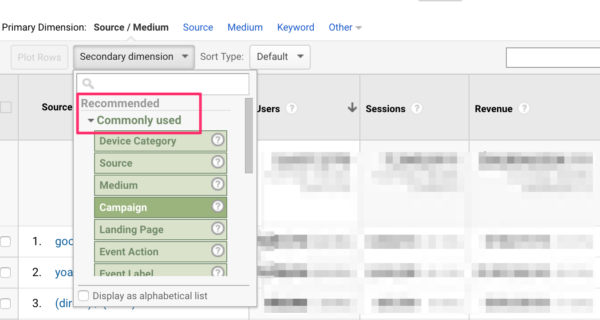Deep Study the 'Secondary Dimension' in Google Analytics: Everything You Ought To Understand
Deep Study the 'Secondary Dimension' in Google Analytics: Everything You Ought To Understand
Blog Article
Navigating the Depths of Secondary Dimension in Google Analytics: A Thorough Expedition on Its Performance
In the world of electronic analytics, the complexities of data analysis commonly hold the trick to opening important understandings. Within the expansive toolkit of Google Analytics lies a feature that acts as a concealed treasure for those that look for a deeper understanding of user habits and website efficiency. Additional dimensions, though seemingly uncomplicated at first glance, harbor a wide range of untapped potential waiting to be utilized. As we start this journey to check out the nuanced functionality of secondary measurements, we will reveal just how this function can brighten patterns, introduce correlations, and inevitably lead the means for informed decision-making in the digital landscape.
Recognizing Second Measurements in Google Analytics

Recognizing just how additional measurements work is essential for leveraging the complete power of Google Analytics. By integrating key metrics with second measurements, you can gain important insights that drive educated decision-making and optimization methods.
Leveraging Additional Dimensions for Information Evaluation
Building upon the foundational understanding of just how secondary dimensions boost information evaluation in Google Analytics, the use of these extra layers of information comes to be critical in extracting beneficial understandings for notified decision-making and optimization methods. By leveraging second dimensions, analysts can delve much deeper right into the efficiency metrics by adding even more context to the primary measurements, therefore revealing surprise patterns and relationships that could not be evident initially glance. This much deeper level of evaluation enables services to better recognize user behavior, recognize trends, and identify locations for improvement.
Moreover, additional dimensions offer an even more extensive view of the information, permitting division based on different criteria such as demographics, devices, web traffic resources, and extra. This segmentation assists in an extra granular analysis, making it possible for services to customize their approaches and projects to particular target market segments for improved targeting and customization. Fundamentally, the critical use additional measurements empowers organizations to make data-driven decisions that drive growth and success in the digital landscape.
Advanced Methods for Second Dimension Implementation
Discovering elaborate techniques to harness the complete capacity of secondary measurements in Google Analytics elevates the deepness and sophistication of data evaluation for calculated decision-making. One advanced technique for implementing additional dimensions is the usage of customized measurements. In addition, incorporating second measurements with advanced segments can offer even much more granular understandings by using numerous layers of segmentation to the data.
Interpreting Insights With Additional Measurements

When translating understandings via additional dimensions, it is important to take into consideration the context of the data and how different dimensions communicate with each other. Understanding which certain traffic sources lead to greater conversion rates or recognizing which gadgets users choose for making acquisitions can give actionable insights check my source for optimizing marketing projects and boosting total web site performance. By thoroughly checking out the information with second dimensions in mind, services can make educated choices that drive purposeful outcomes and boost their digital presence.
Enhancing Performance With Second Measurements

One crucial way to maximize efficiency with secondary dimensions is by segmenting information more granularly. This allows you to isolate specific variables that might be influencing your metrics and get a better understanding of what drives success or failing in your digital campaigns. As an example, by incorporating second dimensions such as 'tool category' and 'touchdown page,' you can identify which device kinds are most efficient for certain landing pages, allowing you to customize your methods as necessary.
Furthermore, making use of second dimensions can help you determine patterns, patterns, and connections that may not appear when assessing information with main measurements alone. This much deeper level of analysis can cause even more enlightened decision-making and ultimately improve the general efficiency of your web site or Get More Info digital advertising and marketing campaigns.
Conclusion
To conclude, second dimensions in Google Analytics play an important duty in improving data analysis and supplying much deeper understandings right into web site efficiency. By utilizing sophisticated methods and interpreting the information successfully, organizations can enhance their methods and improve general performance. Understanding the capability of second dimensions is crucial for making educated decisions and driving success in the digital landscape.
By leveraging secondary dimensions, experts can delve deeper into the performance metrics by including even more context to the key measurements, therefore discovering concealed patterns and connections that may not be obvious at very first glimpse. One sophisticated technique for carrying out second dimensions is the usage of customized dimensions.Having grasped sophisticated techniques like custom measurements and regex for secondary dimension implementation in Google Analytics, the next important step is analyzing the beneficial understandings acquired through these sophisticated information division methods. Analyzing understandings via second measurements involves assessing the relationships between the secondary and primary dimensions chosen, uncovering patterns, patterns, and connections that may not be promptly evident when looking at the data in its totality.When interpreting insights via second measurements, it is essential to this take into consideration the context of the data and exactly how different measurements communicate with each various other.
Report this page